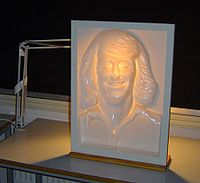
Hollow-Face illusion
Encyclopedia

Optical illusion
An optical illusion is characterized by visually perceived images that differ from objective reality. The information gathered by the eye is processed in the brain to give a perception that does not tally with a physical measurement of the stimulus source...
in which the perception of a concave mask of a face appears as a normal convex face.
While a convex face will appear to look in a single direction, and a flat face such as the Lord Kitchener Wants You
Lord Kitchener Wants You
A 1914 recruitment poster depicting Lord Kitchener, the British Secretary of State for War, above the words "WANTS YOU" was the most famous image used in the British Army recruitment campaign of World War I. It has inspired many imitations.-Origins:...
poster can appear to follow the moving viewer, a hollow face can appear to move its eyes faster than the viewer: looking forward when the viewer is directly ahead, but looking at an extreme angle when the viewer is only at a moderate angle.
Says Richard Gregory
Richard Gregory
Richard Langton Gregory, CBE, MA, D.Sc., FRSE, FRS was a British psychologist and Emeritus Professor of Neuropsychology at the University of Bristol.-Life and career:...
, "The strong visual bias of favouring seeing a hollow mask as a normal convex face (figure 1), is evidence for the power of top-down knowledge for vision" (Gregory 1970). This bias of seeing faces as convex is so strong it counters competing monocular depth cues, such as shading and shadows, and also very considerable unambiguous information from the two eyes signalling stereoscopically that the object is hollow. (Lighting a concave face from below to reverse the shading cues making them closer to those of a convex face lit from above can reinforce the illusion.)
Another example of the Hollow-Face illusion is the "Gathering For Gardner
Martin Gardner
Martin Gardner was an American mathematics and science writer specializing in recreational mathematics, but with interests encompassing micromagic, stage magic, literature , philosophy, scientific skepticism, and religion...
" dragon. This dragon's head seems to follow the viewer's eyes everywhere (even up or down), when lighting, perspective and/or stereoscopic cues are not strong enough to tell its face is actually hollow. Keen observers will note that the head doesn't actually follow them, but appears to turn twice as fast around its center than they do themselves.

